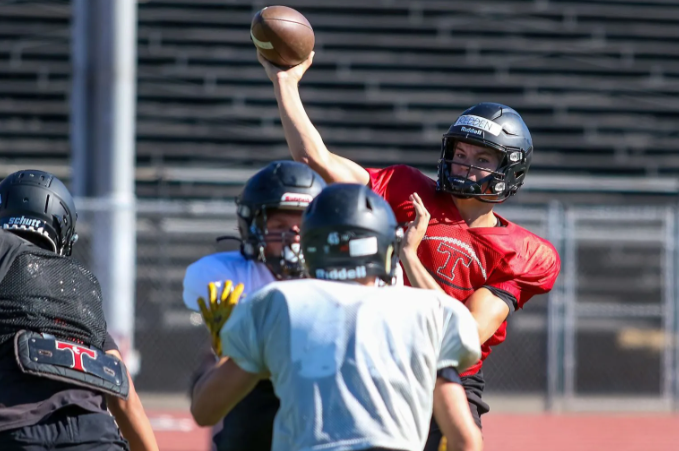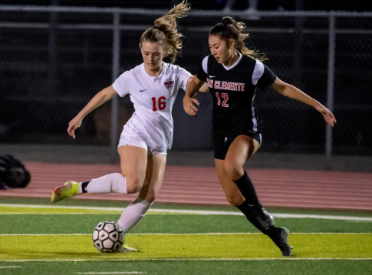
Makenzie Drunasky | Writer
September 26, 2024
At San Clemente High School, the competitive spirit associated with athletics is now stronger than ever. With the number of students joining sports teams standing at astronomically large amounts, SCHS’s athletic department continues to thrive. However, such success is bound to draw in unexpected challenges, such as how sports teams are now knee-deep in the ongoing battle for field space. With the significant rise of student participation in new activities, such as girls’ flag football, it has now gotten out of hand. As one might expect, the increase in the number of sports teams necessitates adding more practices to the schedule. But with only one main turf stadium, and a measly neighboring grass stretch, this task has been found challenging.
As a result, many teams have been forced out of SCHS grounds, having no choice but to retreat to off-campus locations. Although this may seem like a rational solution at first glance, it has produced a series of new conflicts. With many of these fields located miles away from the school, students are often required to rely on parents or other teammates for transportation, adding additional stress to their already busy schedules. For students without a car of their own, depending on parents to get to and from practice may be the only option, or rather, not an option at all.
“I’ve had to miss practice a couple of times because my mom was at work and couldn’t take me,” said sophomore Emily Saw, a lacrosse player who has yet to get her driver’s license. Without field space on campus, she struggles to get to her newly relocated practice at Vista Hermosa Sports Park. “My mom just expects to pick me up at 3:20 as she would usually do. Traveling from school to another field requires my mom to pick me up after lunch, before 5th period, but she is usually working at that time.” Missing out on practices doesn’t look good for any player, as well as the team and school as a whole.
In addition to the inconvenience, practicing off-campus can poke holes in a team’s dynamic. The minimal use of the school’s equipment and facilities can strain a team’s relationship and bond with the school. In many cases, players have developed a sense of disconnection from the rest of the school’s athletic program. Sophomore soccer player Bella Cameron compares her experience to that of “an outcast” and validates the detached feeling that comes along with having to practice on foreign grounds. “It doesn’t even feel like we’re part of the school anymore. It’s like we are being pushed out.”
The feeling of self-doubt can have detrimental effects on a team’s performance and motivation. Being pushed out of school grounds due to another sport that may not even be in season doesn’t help confidence levels.
On a similar subject, players and teams are seeing the battle for grass as a prime example of discrimination among certain sports. Sophomore lacrosse player Chloe de Traversay points out the clear favoritism toward the football program. “I just feel like the football team is treated a whole lot better than a lot of the other sports,” she said.
The high-profile sport has always dominated the fall season. However, even in later sessions of the year, when sports like lacrosse are in season, football still manages to take priority. With the insubstantial supply of fields, other sports teams are brutally forced out, often resulting in shorter practices, or sometimes no practice at all. De Traversay continues to express her frustration, “it’s like we have to work around football’s schedule, even when it’s not their season. Sometimes the football team just randomly decides to extend their practice, causing ours to run late which makes me have less time for homework,” she said.
The short supply of fields affects not only SCHS’s students but also the parents. Parents already have busy schedules of their own, and scrambling to pick their child up from school early and transport them to a sports class across town serves as a major inconvenience.

“All these different field locations are confusing me,” says proud Triton soccer mom, Caren Hagan, “I can never keep track of which field I need to take my daughter to. I’m usually running errands when the kids are at school, but I have to cut it short because I have to pick up my daughter early from school to take her to her soccer class all the way across town. I don’t have time for that!”
The struggle for field space intensifies as the seasons overlap. The high school football team, girls’ soccer team, and girls’ lacrosse team are often found cramping into our single-turf stadium during the fall. With that being the case, our sports team’s performance in games is a great threat. Crowded fields often provide an overwhelming and inefficient practice location. Wandering soccer balls can easily interrupt ongoing lacrosse drills with the practice’s close proximity to each other, thus creating detrimental distractions. “It really has affected our performance in games,” said sophomore lacrosse player Addison Ortega as she recalls her experience having to split the field with the girls’ soccer team. “Soccer balls were flying from every direction, making frequent interruptions to our drills. It’s frustrating because we can’t practice the way we need to.”
These conflicts are not just inconveniences–they serve as real consequences to athletes’ performances on and off the field. It is essential that the school administration becomes aware of this ongoing issue and takes the necessary steps in the right direction. For now, student-athletes are doing their best to navigate the challenges and make the best of what’s given. Significant investment is needed to provide for more field space. But until then, the “clash for the grass” will continue as teams battle not only their opponents but also each other for the space to practice and succeed.

Leave a Reply